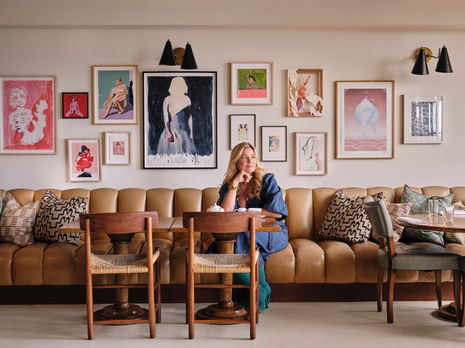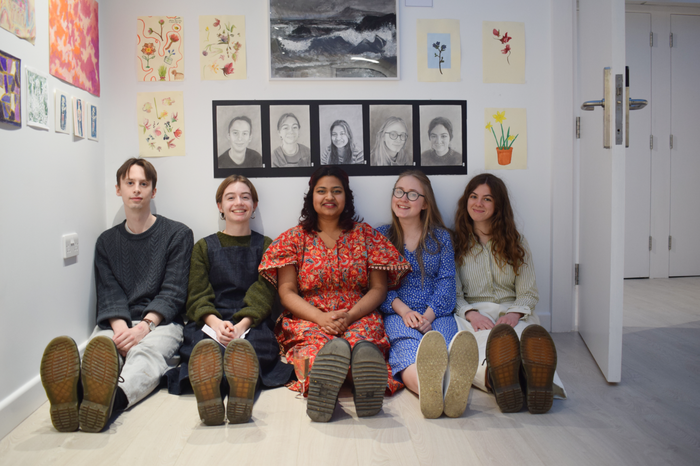Kate Bryan breaks the glass ceiling
Loveday Cookson interviews triple-threat curator, art historian, and broadcaster Kate Bryan

What began as a hopeful email sent with nervous anticipation finds me picking my way through the Strand; wisps of clouds are streaked overhead across a blue sky, swelling with the potential of a new season. Generous with both her time and conversation, Bryan has invited me for lunch at 180 Soho House, just one of an entire network of creative hubs of which she is the head of collections, curating the art adorning each private clubhouse. But more than curator, Bryan is multitudinous in her artistic roles; she populated my lockdown viewing, serving as one third of the judging team for Portrait and Landscape Artist of the Year, enthralling me with a passion for art that surpassed my hastily assembled GCSE coursework. Alongside this, she’s written several books, cataloguing historical artistic couples in The Art of Love while her most recent publication indexes the tragedy of artists lost before their time in Bright Stars.
Stepping out of the lift, I am met by a radiant, self-assured Bryan, her success not the result of privilege or luck but the product of unwavering hard work in the face of deep-rooted inaccessibility. Having been educated at a comprehensive school, the first in her family to attend university and with “no connections, money or work experience,” Bryan’s path into the art world was the product of a childhood enchantment with Van Gogh’s paintings and personal drive undeterred by her lack of a formal artistic background.
“Attending Warwick University, Bryan soon discovered it was not the academia she found daunting but the cultural shock”
Attending Warwick University, Bryan soon discovered it was not the academia she found daunting but the cultural shock, realising “I really have a lot to learn about the world.” A common phenomenon when entering university, I wonder whether she has traversed imposter syndrome, now feeling like an ‘insider’ in the historically elite community of the art trade. She cites her job at Soho House, along with the completion of her first book, as a moment of realisation of having ‘made it’, giving her the opportunity to pursue her love of art and to build a platform to uplift other artistic voices. Reflecting on her university experience, Bryan believes herself to be “part of a generation who we believed the world was going to look after”; an optimistic sentiment quashed by the impending financial crash of 2007. Instead, “all the big breaks I’ve got is because I’ve been able to show I’ve done the work.”
Bryan explains how, following exhibitions, she would make copious notes. Her voracious love of learning would later impress interviewers and help secure her highly-sought roles, such as her work on the once-in-a-generation Michelangelo exhibition at the British Museum in 2006. Prior to this, she was employed by the museum predominantly to make coffee. “I interviewed my heart out for the job,” she says, believing that “if I could get my foot in the door, I could work my way up”. More than happy to make coffee at the outset and believing early roles are “about building knowledge that you cannot buy,” Bryan has an incredible capacity to balance her present endeavours with a forward gaze. She sees the potentiality in tea runs, just as she mentors individual artists with a view for artistic revolution.
“She sees the potentiality in tea runs, just as she mentors individual artists with a view for artistic revolution”
Her vision and confidence are well-placed, rightfully unapologetic about her stratospheric achievements. While ambitious to carve out space for those coming up, she isn’t trying to “tear down the temple,” just “create lots of doors.” She does so through the employment of interns from historically underrepresented backgrounds, as well as her continual work addressing gender inequality, as in her permanent installation ‘The Vault 100’. Seeking to rebalance the gender disparity in displayed artists, she used the work of ninety-three women and seven men to highlight the continued exclusion of women from art. Nestled in the heart of the city, the project serves as a continual reminder of the unrelenting barriers faced by women in artistic spaces.
How does she manage to balance her myriad roles? A self-confessed “Mrs Side Hustle,” Bryan laughs that she doesn’t “have the luxury of having writer’s block.” She snatches moments on family holidays, conducive to her role as a parent as well as writer, while insisting writing doesn’t have to be pedestalled as a grand action, but can be simply taking notes on the tube. Her pragmatic approach to writing translates into her compelling curatorial approach, insisting on art’s existence beyond the narrowness of gallery walls. For her, great art and writing are as simple as “go[ing] back to the art always” and telling stories with “lucidity and clarity.” Bright Stars brims with emotive stories, but in her pragmatism Kate attempts to focus her empathy for the individuals into scorn towards the art world, allowing her to retain the critical distance that reminds us that “at the heart it is always talking about why the art is great”. An evocative writer, Bryan doesn’t want to be “living and dying by the sell”, which is the reality of the corporate art world: instead, she lives by the ethos that “creative people need autonomy.” This sentiment resounds in the freedom of her daily commute, choosing to walk from her home in South London, immersing herself in the city, rather than using prescriptive public transport.
“Writing doesn’t have to be pedestalled as a grand action, but can be simply taking notes on the tube”
I wonder, with such mass exposure to art that the city affords, how this affects Bryan’s interaction with the field. Does art still feel like her early introductions to Van Gogh, or does the saturation of talent progressively blur – like a late Turner painting, the landscape rich and vibrant but increasingly indefinable? Bryan explains that despite being an “insider”, she retains “that childlike joy”; when her daughter is drawing or creating, Bryan often finds herself colouring or copying a Van Gogh, a return to her initial introduction to the beauty of art. “Art is a language of its own” and every once in a while, despite the mass exposure to masterpieces, she will see a piece of art that is so infinitely compelling it “hits [her] on some solar plexus deep level”, like her current love for Artemisia Gentileschi’s works. While Bryan does not revel in her own artistic creations, she never brands them as ‘bad’; “bad implies some moralistic or objective quality which we know can’t happen”. She insists that art truly is for everyone, as “you don’t have to be Tiger Woods to play mini golf.” Instead, when copying and colouring “you are really engaged in the art of looking,” which is what art boils down to: truly “looking”.
I press the doors of 180, reflecting on the myriad of doors that Bryan has opened during her career thus far; her values are not empty promises, but a continual commitment to accessibility, pursued with the intensity with which she studied those early exhibitions. Inspired by Bryan’s enchantment with the outdoors, I forgo public transport, instead wandering through the sun-laden streets with the clouds now nothing but a smattering of freckles; I really “engage in the art of looking,” as she implores. When looking forward to Bryan’s legacy, I have no doubt it will be anything other than remarkable for both her artistic vision and accessibility activism, nothing short of a ‘bright star’.
 News / Cambridge study finds students learn better with notes than AI13 December 2025
News / Cambridge study finds students learn better with notes than AI13 December 2025 News / Cambridge Vet School gets lifeline year to stay accredited28 November 2025
News / Cambridge Vet School gets lifeline year to stay accredited28 November 2025 Science / Did your ex trip on King’s Parade? The science behind the ‘ick’12 December 2025
Science / Did your ex trip on King’s Parade? The science behind the ‘ick’12 December 2025 News / Uni Scout and Guide Club affirms trans inclusion 12 December 2025
News / Uni Scout and Guide Club affirms trans inclusion 12 December 2025 Arts / Modern Modernist Centenary: T. S. Eliot13 December 2025
Arts / Modern Modernist Centenary: T. S. Eliot13 December 2025










